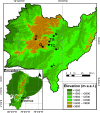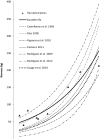Impacts of pine plantations on carbon stocks of páramo sites in southern Ecuador - PubMed (original) (raw)
Impacts of pine plantations on carbon stocks of páramo sites in southern Ecuador
Carlos Quiroz Dahik et al. Carbon Balance Manag. 2021.
Abstract
Background: Since the 1990's, afforestation programs in the páramo have been implemented to offset carbon emissions through carbon sequestration, mainly using pine plantations. However, several studies have indicated that after the establishment of pine plantations in grasslands, there is an alteration of carbon pools including a decrease of the soil organic carbon (SOC) pool. The aim of this study is to investigate the impact of the establishment of pine plantations on the carbon stocks in different altitudes of the páramo ecosystem of South Ecuador.
Results: At seven locations within an elevational gradient from 2780 to 3760 m a.s.l., we measured and compared carbon stocks of three types of land use: natural grassland, grazed páramo, and Pinus patula Schlltdl. & Cham. plantation sites. For a more accurate estimation of pine tree carbon, we developed our own allometric equations. There were significant (p < 0.05) differences between the amounts of carbon stored in the carbon pools aboveground and belowground for the three types of land use. In most of the locations, pine plantations revealed the highest amounts of aboveground and belowground carbon (55.4 and 6.9 tC/ha) followed by natural grassland (23.1 and 2.7 tC/ha) and grazed páramo sites (9.1 and 1.5 tC/ha). Concerning the SOC pools, most of the locations revealed significant lower values of plantations' SOC in comparison to natural grassland and grazed páramo sites. Higher elevation was associated with lower amounts of pines' biomass.
Conclusions: Even though plantations store high amounts of carbon, natural páramo grassland can also store substantial amounts above and belowground, without negatively affecting the soils and putting other páramo ecosystem services at risk. Consequently, plans for afforestation in the páramo should be assessed case by case, considering not only the limiting factor of elevation, but also the site quality especially affected by the type of previous land use.
Keywords: Aboveground biomass; Belowground biomass; Carbon pools; Carbon sequestration; Land use change; Soil organic carbon.
Conflict of interest statement
The authors declare that they have no competing interests.
Figures
Fig. 1
Map of Azuay province showing the seven locations of the study from the lowest to the highest in elevation: Irquis (I), Nero (N), La Paz (L), Tutupali Chico (TC), Tutupali Grande (TG), Quimsacocha (Q) and Soldados (S)
Fig. 2
Aboveground biomass estimation curves calculated with the allometric equations developed for P. patula including the data calculated with Ba (Eq. 2). The graph includes the biomass of the nine harvested pine trees
Similar articles
- Carbon sequestration rates indicate ecosystem recovery following human disturbance in the equatorial Andes.
Calderón-Loor M, Cuesta F, Pinto E, Gosling WD. Calderón-Loor M, et al. PLoS One. 2020 Mar 30;15(3):e0230612. doi: 10.1371/journal.pone.0230612. eCollection 2020. PLoS One. 2020. PMID: 32226044 Free PMC article. - Changes in Biomass Carbon and Soil Organic Carbon Stocks following the Conversion from a Secondary Coniferous Forest to a Pine Plantation.
Li S, Su J, Liu W, Lang X, Huang X, Jia C, Zhang Z, Tong Q. Li S, et al. PLoS One. 2015 Sep 23;10(9):e0135946. doi: 10.1371/journal.pone.0135946. eCollection 2015. PLoS One. 2015. PMID: 26397366 Free PMC article. - Mixed plantations enhance more soil organic carbon stocks than monocultures across China: Implication for optimizing afforestation/reforestation strategies.
Xiang Y, Li Y, Luo X, Liu Y, Huang P, Yao B, Zhang L, Li W, Xue J, Gao H, Li Y, Zhang W. Xiang Y, et al. Sci Total Environ. 2022 May 15;821:153449. doi: 10.1016/j.scitotenv.2022.153449. Epub 2022 Jan 29. Sci Total Environ. 2022. PMID: 35093345 - Dynamics of soil carbon and nitrogen stocks after afforestation in arid and semi-arid regions: A meta-analysis.
Liu X, Yang T, Wang Q, Huang F, Li L. Liu X, et al. Sci Total Environ. 2018 Mar 15;618:1658-1664. doi: 10.1016/j.scitotenv.2017.10.009. Epub 2017 Nov 1. Sci Total Environ. 2018. PMID: 29074238 Review. - Progress in understanding the hydrology of high-elevation Andean grasslands under changing land use.
Mosquera GM, Marín F, Stern M, Bonnesoeur V, Ochoa-Tocachi BF, Román-Dañobeytia F, Crespo P. Mosquera GM, et al. Sci Total Environ. 2022 Jan 15;804:150112. doi: 10.1016/j.scitotenv.2021.150112. Epub 2021 Sep 4. Sci Total Environ. 2022. PMID: 34520909 Review.
References
- Dickinson JC. The Eucalypt in the Sierra of southern Peru. Ann Assoc Am Geogr. 1969;59(2):294–307. doi: 10.1111/j.1467-8306.1969.tb00672.x. - DOI
- Gade DW. Nature and culture in the Andes. Madison: University of Wisconsin Press; 1999. p. 287.
- Rhoades RE. Development with identity : community, culture and sustainability in the Andes. Wallingford: CABI Pub; 2006. p. 325.
- Farley KA. Grasslands to tree plantations: fForest transition in the Andes of Ecuador. Ann Assoc Am Geogr. 2007;97(4):755–771. doi: 10.1111/j.1467-8306.2007.00581.x. - DOI
- Hofstede R, Lips J, Jongsma W. Geografía, Ecología y Forestación de la Sierra del Ecuador. Quito: Abya-Yala; 1998.
LinkOut - more resources
Full Text Sources
Other Literature Sources

